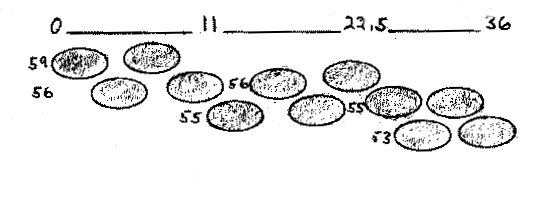
HITHER GATE MUSIC

HITHER GATE MUSIC
Goal: a series of deep, soft, resonant bubbles
that overlap and descend

Source: a hog-like animal cry, CUT from a soundfile containing the cries of several different animals: hog.wav (3.7 sec).
Initial processing begins with some housekeeping work. Gain x 2 is applied to give it a reasonable amplitude: hogg.mp3. This then DOVETAILED to give it a strong, but controlled attack transient (0.5 sec, starting slowly and the rising in amplitude more quickly – the 'exponential' setting) and a smooth decay (smooth linear decay over 1 sec.). Now we have hoggdt.mp3.
The sound is first transformed by RING MODULATION. 1000 Hz is both added to and subtracted from the original sound, creating a 1000 Hz empty zone in the middle: hoggdtrm.mp3.
The second transformation process is FILTERBANK SUBHARMONIC, i.e., filter the sound through a bank, a descending series of resonant frequency centres.
The 'double-filtering' option is used in order to increase the resonant effect. The somewhat amazing result is: hoggdtrmfsub.mp3, which is CUT to 4 sec. duration to create the final result: hoggdtrmfsubc.mp3.Q GAIN HIFRQ --> LOFRQ 75 25 1000 100Stage 2 – create the series of descending bubbles
The desired long, descending, deep-down, resonant bubble texture is achieved with TEXTURE SIMPLE, Mode 4 (changing harmonic sets), with an output duration of 50 seconds. The event-density is a slow 2.4 seconds, widely offset by up to 0.7 seconds.
The key to the creation of this texture is providing 3 descending pairs of pitches in such a way that the software selects at random which pitch of the pair it will use for any given note event. Thus you will hear the final texture oscillate unpredictably between the pitches of each pair. The input sound made for this texture is very long, so the various iterations of the sound overlap a great deal. This overlap makes the movement downwards to the next pair of pitches very smooth, as the sounds on the previous pitches are still ringing on.
These are the pairs of pitches, with the times at which they change indicated below the stave:
Only these pitches are used: all notes are snapped to the specified harmonic set pairs during each of the time periods when they are active.
In the final result, then, we can hear a slow, irregular movement, and an unpredictable oscillation between pairs of pitches, with the overlapping bubbles gradually descending over the 50 second period. A little GAIN is applied to restore some of the volume loss during filtering. hoggdtrmfsubclongtex1g.mp3.
Last updated: 26 September 2003
mp3 format changes: 21 February 2010 (sources or near sources are kept as wav)
©2003-2010 Archer Endrich Chippenham, Wiltshire England, both texts and music. All rights reserved.